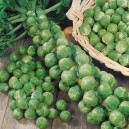
Welcome, Log in
Product Categories
-
Heirloom & OP Seed
- Cool Weather Crops
- Warm Weather Crops
- Beans
- Beetroot
- Brassicas
- Carrots
- Chard
- Corn/Maize
- Cucumbers
- Eggplant (Aubergine)
- Leeks
- Lettuce
- Melons
- Okra
- Onions
- Parsnips
- Peas
- Peppers & Chillies
- Radish
- Spinach
- Squash & Pumpkins
- Tomatoes
- Turnips
- Unusual / Exotic
- Herbs & Spices
- Fruits & Berries
- Value Packs
- View All Seed
- Gift Vouchers
Brussels SproutsThere is 1 product.
Please scroll down or click here to view the product list
GROWING INSTRUCTIONS FOR BRUSSELS SPROUTS
Binomial Name: Brassica oleracea
Varieties: Long Island Improved
Start: Seeds or seedlings
Germination: 5 - 8 days, 7°C to 30°C
Seed Life (viability): 5 years
Soil: Well drained and fertile
Sunlight: Full sun
Sow Seeds: 8 to 10 cm apart
Transplant Seedlings: 45 to 60 cm apart
Ave. Days to Harvest: 80 to 105
Good Companions: Beans, Celery, Dill, Hyssop, Mint, Nasturtium, Potato, Sage, Thyme
Bad Companions: Strawberry, Tomato
Sowing & Planting: Brussels sprouts are slow-growing, long-season vegetables belonging to the cabbage family. The sprouts look like miniature cabbages and form where the leaves meet the stems. Both the foliage and the sprouts have a bluish cast. Freshly harvested, lightly steamed sprouts are a delight.
Brussels sprouts require good soil, timely planting and protection from pests. This cool-season crop grows best when daytime temperatures are in the range of 15°C to 20°C. Depending on your climate you can grow Brussels sprouts in both spring and autumn but avoid growing during summer as hot weather can cause premature bolting.
For spring crops, sow seeds indoors in seedling trays 5 to 7 weeks before the last average frost date and keep the soil warm (about 24°C) until germination. Then keep the plants at around 15°C. Provide direct sun so seedlings don’t get leggy.
When seedlings are 4 to 6 weeks old, transplant into garden 45 to 60 cm apart. Protect transplants from hard frosts with newspapers, plastic cones, paper bags, or baskets and provide a windbreak to reduce transplant shock and moisture loss. For autumn/winter crops you can also direct seed straight into the garden 85 to 100 days before the average first frost date (around mid-summer).
Brussels sprouts prefer well-drained, fertile soil high in organic matter, pH 6.0 to 7.5. Can tolerate slightly alkaline soil. Needs plentiful, consistent moisture. Select a site with full sun and well-drained soil. Brussels sprouts can also tolerate light shade but this will slow maturity. Prepare the garden bed by using a garden fork or tiller to loosen the soil to a depth of 30 to 40 cm, then mix in a good 5 to 10 cm layer of compost.
Growing: Apply a good layer of compost again halfway through the season. Plants have shallow root systems though so try and avoid even shallow cultivation. Mulch well to protect roots, reduce weed competition and conserve moisture. Use floating row covers to help protect from early insect infestations. To help reduce disease, do not plant Brussels sprouts or other cole crops in the same location more than once every three or four years.
Harvesting: It takes some time for sprouts to mature so you will only begin to harvest them about twenty weeks after sowing. Sprout formation will begin at the base of the stalk. To encourage development of the upper sprouts for uniform maturity, pinch out the growing tip of the plant in late summer when bottom sprout is as big as an average thumb. Or harvest sprouts individually from the bottom of the stalk when they are about 2.5 to 3.5 cm in diameter. Autumn planted Brussels sprouts will become sweeter after a few light frosts.
Once harvested, the sprouts can be stored in three ways. Either, leave them on the stem and hang them somewhere cool and dark, a shed is ideal. This way they will keep for up to a month. Alternatively, pick the sprouts from the stem and keep them in your fridge. This way they will last about a week. If you want to freeze them, simply remove any dead or discoloured leaves and, using a sharp knife, cut an X in the base of each sprout. Blanch the sprouts for a few minutes in boiling water and then plunge them into very cold water to cool. Stored in freezer bags they will keep frozen for approximately six months.






